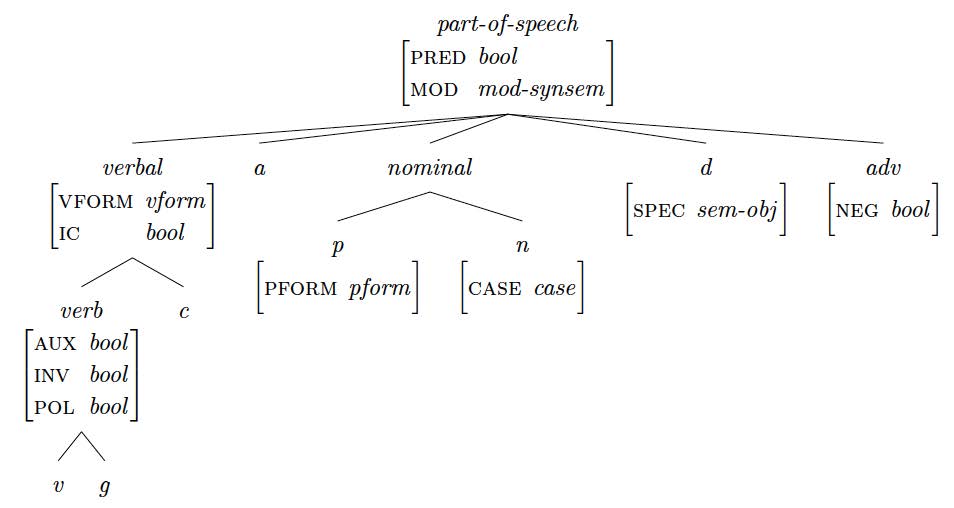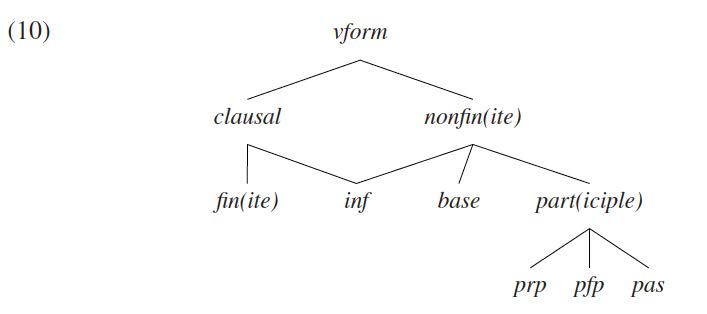Constraint-based Syntax 2: Week 2
Parts of Speech
Our online grammar uses the following type hierarchy for parts of speech (the values of the feature HEAD):
The hierarchy differs from that in GS in containing the part of speech adverb. The following table lists the parts of speech, their features, and the function of the features:
a. The maximal part of speech types are the following:
| Type | Full name | Examples |
|---|---|---|
| v | verb | snore, like, must, to |
| g | gerund | snoring, liking |
| c | complementizer | that, whether, if |
| a | adjective | big, new, red |
| p | preposition | to, of, with |
| n | noun | Lilly, she |
| d | determiner | the, a, any |
| adv | adverb | early, very, not |
Note that v and g are grouped together, since verbs and gerunds behave very similarly. Perhaps surprisingly, complementizers are also grouped together with verbs and gerunds, so that all three parts of speech share the head features VFORM (verb form) and IC (independent clause). We will see later why that is useful.
Head Features
The next table lists all the head features of all the parts of speech and explains their function:
| Feature | Value type | Function of the feature |
|---|---|---|
| PRED(icative) | boolean | Is the sign predicative or not? |
| MOD(ification) | mod-synsem | Can the sign modify and if yes, what kind of synsem? |
| VFORM (verb form) | vform | What is the verb's verb form? |
| IC (independent clause) | boolean | Is the sign (the head of) an independent clause? |
| AUX | boolean | Is the sign (the head of) an auxiliary construction? |
| INV(erted) | boolean | Is the sign an inverted auxiliary (construction)? |
| POL(arized) | boolean | Is the verb a polarized auxiliary (not, TOO, so)? |
| P(reposition)FORM | form | Which preposition is it? |
| CASE | case | What case does the nominal sign carry? |
| SPEC(ifying) | sem-obj | Which semantic object does the D specify? |
| NEG(ation) | boolean | Is the adverb the negation not? |
The verb form hierarchy
The different verb forms that the framework makes available form another important aspect of the theory:
In the text, GS also talk about a verb form subjunctive which is supposed to be used in imperative and subjunctive clauses. They do, however, not include that verb form in their grammar specification. In order to analyze these sentence types, the online grammar for this course adds a verb form sbjn" (= subjunctive) to the type hierarchy above. It assumes that sbjn" is another immediate subtype of clausal", so that clausal has the three immediate subtypes sbjn", fin(ite), and inf(initive). There will be a constraint that clauses are required to have a clausal part of speech, which means that only words with VFORM sbjn", fin(ite), or inf(initive) can head clauses.
The table below gives an overview of all verb forms with examples:
| Verb form | Full name | Examples |
|---|---|---|
| sbjn | subjunctive | be, dance, call |
| fin | finite (indicative) | is, must, dances, dance (non-third person singular), danced (past tense) |
| inf | infinitive | to (the infinitive marker) |
| base | base form (= bare infinitive) | be, dance, call |
| prp | present participle | being, dancing, calling |
| pfp | perfect participle | been, danced, given |
| pas | passive participle | invited, rumored, introduced |
Valence
In Week 1 we saw that all signs carry the 3 valence features SUBJ, SPR, and COMPS, which are list-valued. Corresponding to each valence feature, there is a phrase type: hd-subj-ph, hd-spr-ph, and hd-comp-ph. As the names suggest, each phrase has a head daughter and additionally a SUBJ, SPR, or one or two COMPS daughters. The projection of these phrases is driven by the head daughters valence features as illustrated in Week 1.
The linguistic objects on the valence lists (i.e. the valents) are of type synsem. In order to simplify the representations of the valents, we use the following abbreviations:
VP = a phrase of part of speech v which is COMPS <> , SPR <>, and SUBJ <synsem>
AP = a phrase of part of speech a which is COMPS <> , SPR <>, and SUBJ <synsem>
S = a phrase of part of speech v which is COMPS <>, SPR <>, and SUBJ <>
NP = a phrase of part of speech n which is COMPS <>
PP = a phrase of part of speech p which is COMPS <> , SPR <>, and SUBJ <>
This permits us to write valence lists like the following, where the information in the brackets further specify inflectional properties of the valents which should be self-explanatory:
| Example | Valence list |
|---|---|
| snores | <NP[nom]> |
| likes | <NP[nom],NP[acc]> |
| put | <NP,NP[acc],PP> |
| persuade | <NP,NP,VP[inf]> |
| afraid | <NP,PP> |
| of | <NP[acc]> |
| that (C) | <S[fin]> |
Words
So far, we have introduce the following concepts:
- Our grammar deals with signs which are either words or phrases.
- Every sign belongs to a maximal part of speech, which may have features.
- Signs also have the 3 valence attributes SUBJ, SPR, and COMPS which contain a description of the syntactic and semantic information of other signs.
- These valence features drive the formation of specific phrases.
In preparation of a more detailed look at phrases, look at the lexical entries of the words in the table below in the online grammar. Where applicable, try out different inflectional forms, e.g. snores, snoring, snored or she, her. Pay attention to the part of speech, its features, and the 3 valence feature of each word:
Online Grammar for Chapter 2: HPSG Background
| Type | Full name | Examples |
|---|---|---|
| v | verb | snore, like, must, to |
| g | gerund | snoring, liking |
| c | complementizer | that, whether, if |
| a | adjective | big, new, red |
| p | preposition | to, of, with |
| n | noun | Lilly, she |
| d | determiner | the, a, any |
| adv | adverb | early, very, not |
Maximal phrase types
In Week 1, the following 3 phrase types were introduced: hd-subj-ph, hd-spr-ph, and hd-comp-ph.
Head-Specifier Phrases
Exercise: parse the 3 expressions cat, a, and a cat in order to see how the valence features of the noun drive the formation of the hd-spr-ph the cat.
Online Grammar for Chapter 2: HPSG Background
For the moment, there is little more to say about head-specifier phrases.
Clauses and non-clauses
GS postulate a distinction between clauses and non-clauses. All clauses have in common that they are phrases and that they must have a content of type message, as follows:
| Clause type | Full name | Content value | Examples |
|---|---|---|---|
| decl-clause | declarative clause | austinian | Lilly danced. |
| inter-clause | interrogative clause | question | Does Lilly dance?, Who danced? |
| imp-clause | imperative clause | outcome | Dance! |
| excl-clause | exclamative clause | fact | "What a cat!, Is Lilly smart! |
Head-Complement Phrases

